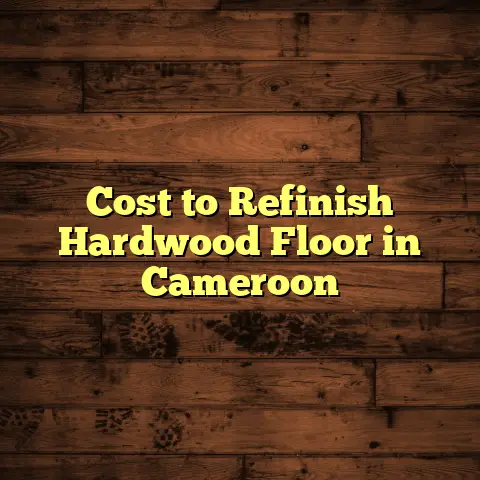Slip-Resistant Tile Flooring? (Cut Install Costs!)
Think about it: a sleek office lobby, a cozy home entryway, or even a bustling restaurant. The floor beneath your feet sets the stage.
Now, imagine that same entryway, but with beautiful, slip-resistant tile. It’s not just about looks; it’s about safety.
Especially in high-traffic areas.
I’m talking about peace of mind knowing your family, customers, or employees are less likely to take a tumble.
Slip-resistant tile flooring?
It’s where style meets function, and it’s what we’re diving into today. Let’s get started, shall we?
Section 1: Understanding Slip-Resistant Tile Flooring
Definition and Importance
Alright, let’s get down to brass tacks.
What exactly is slip-resistant tile flooring?
Simply put, it’s tile designed to provide better traction than your average smooth surface.
This is crucial in preventing slips, trips, and falls. Now, why is this so important?
Well, the statistics speak for themselves.
The National Safety Council reports that falls are a leading cause of unintentional injuries and deaths in the US.
In 2020 alone, falls to a lower level resulted in 805 workplace fatalities (BLS).
That’s a sobering thought, right?
Whether it’s a wet bathroom floor at home, a greasy kitchen in a restaurant, or a slick entryway during a rainstorm, the risk is real.
Slip-resistant tiles mitigate that risk, offering a safer environment for everyone.
Types of Slip-Resistant Tiles
So, what kind of options are out there?
You’ve got a few main contenders:
-
Ceramic: A classic choice, ceramic tiles can be made slip-resistant through texturing or specialized coatings.
-
Porcelain: Denser and more durable than ceramic, porcelain tiles are a great option for high-traffic areas.
-
Vinyl: Luxury vinyl tile (LVT) is becoming increasingly popular.
Many options boast impressive slip resistance and are also waterproof.
-
Natural Stone: Stone like slate or sandstone naturally offers more texture and grip.
However, it can be more porous and require more maintenance.
The key here is the texture and finish. Matte finishes are generally more slip-resistant than glossy ones.
Textured surfaces, like those with a slight orange peel effect or raised patterns, provide even more grip.
Materials and Technologies
Now, let’s geek out a bit on the science behind slip resistance.
It’s all about the Coefficient of Friction (COF).
This measures how much force is needed to start an object sliding on a surface.
The higher the COF, the more slip-resistant the tile.
According to ANSI (American National Standards Institute) standards, a Dynamic Coefficient of Friction (DCOF) of 0.42 or greater is recommended for level interior surfaces expected to be walked upon when wet.
Manufacturers use different materials and technologies to achieve this. Some tiles have abrasives embedded in the surface, creating microscopic bumps that increase friction.
Others use specialized coatings that create a textured surface without sacrificing aesthetics.
For example, some coatings use micro-sized aluminum oxide particles to enhance grip.
These coatings are also incredibly durable and resistant to wear and tear, making them a fantastic long-term investment.
Section 2: The Aesthetic Appeal of Slip-Resistant Tiles
Design Versatility
Okay, so we’ve established that slip-resistant tiles are safe and practical. But what about style?
Does choosing safety mean sacrificing aesthetics?
Absolutely not! The days of drab, purely functional slip-resistant flooring are long gone.
Today, you can find slip-resistant tiles that complement virtually any interior design style.
-
Modern: Large-format porcelain tiles with a subtle texture can create a sleek, minimalist look.
-
Rustic: Natural stone or wood-look vinyl tiles with a pronounced texture can add warmth and character.
-
Industrial: Concrete-look tiles with a matte finish are perfect for achieving that raw, urban vibe.
Color options are virtually limitless, and you can find everything from classic neutrals to bold, eye-catching hues.
Patterned tiles are also a great way to add visual interest, and many manufacturers offer slip-resistant versions of their most popular designs.
Case Studies
Let’s take a look at some real-world examples of how slip-resistant tiles can transform a space.
Case Study 1: A Restaurant Renovation
A local restaurant was struggling with frequent slip-and-fall accidents in their kitchen area.
They opted to replace their existing flooring with slip-resistant porcelain tiles that mimicked the look of natural stone.
The result?
A safer kitchen environment and a more upscale, inviting atmosphere for both staff and customers.
Case Study 2: A Home Bathroom Remodel
A homeowner wanted to create a spa-like bathroom that was also safe for their young children.
They chose slip-resistant ceramic tiles with a subtle wave pattern for the shower floor.
The textured surface provided excellent grip, and the stylish design elevated the entire bathroom.
I’ve personally installed similar tiles in countless homes, and the feedback is always the same: peace of mind and stunning aesthetics.
Section 3: Cost Considerations in Slip-Resistant Tile Installation
Initial Costs vs. Long-Term Savings
Alright, let’s talk money.
How much does slip-resistant tile flooring really cost?
Upfront, it might seem like a bigger investment than standard tile.
But it’s crucial to consider the long-term savings.
Think about it: a single slip-and-fall accident can result in hefty medical bills, legal fees, and increased insurance premiums.
According to the CDC, the average cost of a fall injury is over $30,000.
Investing in slip-resistant flooring can significantly reduce the risk of these accidents, potentially saving you thousands of dollars down the road.
Factors Influencing Installation Costs
So, what factors influence the overall cost of installation? Here’s a breakdown:
-
Tile Selection: Material, size, and design all play a role.
Larger tiles often require less grout and can be quicker to install, but they may also be more expensive per square foot.
-
Subfloor Preparation: A level, stable subfloor is essential for a successful tile installation.
If your subfloor needs repairs or leveling, that will add to the cost.
-
Labor Costs: Labor rates vary depending on your location and the experience of the installer.
It’s always a good idea to get multiple quotes to ensure you’re getting a fair price.
-
Geographic Location and Market Demand: In areas with high demand for skilled tradespeople, labor costs may be higher.
DIY vs. Professional Installation
Can you tackle a slip-resistant tile installation yourself?
Maybe. It depends on your skill level and the complexity of the project.
DIY Pros:
- Cost Savings: You’ll save on labor costs.
- Control: You have complete control over the process.
DIY Cons:
- Time Commitment: It can be time-consuming, especially if you’re new to tiling.
- Potential for Errors: Mistakes can be costly to fix.
- Tool Investment: You’ll need to purchase or rent the necessary tools.
Professional Installation Pros:
- Expertise: Experienced installers know how to properly prepare the subfloor, lay the tile, and grout the joints.
- Warranty: Many installers offer warranties on their work.
- Time Savings: They can complete the job much faster than you could on your own.
Professional Installation Cons:
- Higher Cost: Labor costs can be significant.
If you’re comfortable with basic DIY projects and have the time and patience, a small bathroom floor might be a good place to start.
However, for larger or more complex projects, I always recommend hiring a professional.
Section 4: Tips for Cutting Installation Costs
Alright, let’s get into some strategies for saving money on your slip-resistant tile installation.
Choosing the Right Supplier
Where you buy your tile can have a big impact on the overall cost.
-
Compare Prices: Don’t just go with the first supplier you find. Shop around and compare prices from different retailers.
-
Check for Sales and Discounts: Many suppliers offer seasonal sales or discounts on bulk purchases.
-
Negotiate: Don’t be afraid to negotiate! Especially if you’re buying a large quantity of tile.
Timing the Installation
When you schedule your installation can also affect the cost.
-
Off-Peak Seasons: During slower periods, installers may be more willing to offer discounts.
-
Promotional Months: Some retailers offer special promotions during certain months.
-
Consider Material Availability: If you’re choosing a popular tile, it may be out of stock during peak seasons.
Creative Solutions for Cost Reduction
Think outside the box! There are plenty of creative ways to save money without compromising quality.
-
Use Remnants or Leftover Tiles: If you have leftover tiles from a previous project, consider using them in a smaller area.
-
Mix Different Styles: Combining different types or styles of tiles can create a unique look and save you money.
For example, you could use a more expensive tile for a border and a less expensive tile for the main floor.
-
Consider Smaller Tiles: Smaller tiles are often less expensive per square foot than larger tiles.
-
Minimize Waste: Plan your layout carefully to minimize cuts and waste.
Section 5: Maintenance and Longevity of Slip-Resistant Tiles
Routine Maintenance Routines
Okay, you’ve got your beautiful, slip-resistant tile installed. Now, how do you keep it looking great and performing well for years to come?
Regular cleaning is key.
-
Sweep or Vacuum Regularly: Remove dirt and debris that can scratch the surface of the tile.
-
Mop with a Neutral Cleaner: Use a pH-neutral cleaner specifically designed for tile.
Avoid harsh chemicals or abrasive cleaners, as they can damage the finish.
-
Rinse Thoroughly: After mopping, rinse the floor with clean water to remove any cleaner residue.
-
Dry the Floor: Use a clean towel or mop to dry the floor. This will help prevent water spots and streaks.
Addressing Wear and Tear
Even with regular maintenance, your tile may eventually show signs of wear and tear.
-
Scratches: Minor scratches can often be buffed out with a soft cloth and a polishing compound.
-
Fading: Prolonged exposure to sunlight can cause some tiles to fade.
Use window coverings to protect your floor from direct sunlight.
-
Grout Issues: Grout can become stained or cracked over time.
Clean grout regularly with a grout brush and a grout cleaner.
If the grout is severely damaged, you may need to have it repaired or replaced.
Regular inspections are also important.
Check for any signs of damage, such as cracks, chips, or loose tiles.
Address any issues promptly to prevent them from worsening.
Conclusion: The Smart Choice for Safety and Style
So, there you have it!
Slip-resistant tile flooring is a smart investment for anyone who values safety and style.
It’s not just about preventing accidents; it’s about creating a more comfortable and inviting environment for everyone.
While the initial cost may be higher than standard tile, the long-term benefits far outweigh the expense.
From reduced liability to increased peace of mind, slip-resistant tile is a worthwhile investment for any home or business.
And with the wide variety of styles and designs available, you don’t have to sacrifice aesthetics to achieve a safer space.
So, what are you waiting for?
Start exploring your options today and discover the perfect slip-resistant tile for your next project!





